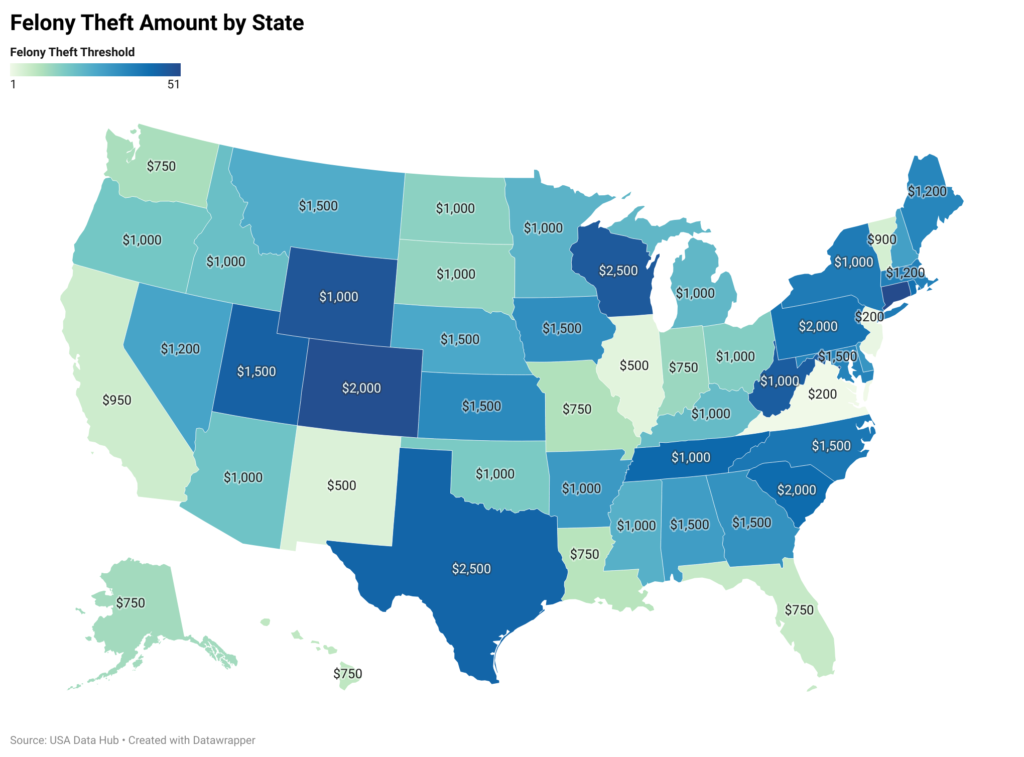Felony Theft Amount by State
Felony theft laws vary significantly from state to state in the United States, with each jurisdiction defining its own threshold for criminal charges. In this data analysis article, we delve into the provided data to uncover insights into felony theft thresholds and shed light on the diverse approaches taken by different states
Top 10 States with Higher Felony Theft Thresholds:
- Texas ($2,500)
- Wisconsin ($2,500)
- Colorado ($2,000)
- Connecticut ($2,000)
- South Carolina ($2,000)
- Pennsylvania ($2,000)
- Rhode Island ($1,500)
- New Hampshire ($1,500)
- Delaware ($1,500)
- Florida ($750)
Top 10 States with Lower Felony Theft Thresholds:
- Virginia ($200)
- New Jersey ($200)
- Illinois ($500)
- New Mexico ($500)
- Vermont ($900)
- California ($950)
- Hawaii ($750)
- Louisiana ($750)
- Missouri ($750)
- Washington ($750)
Low Thresholds: Virginia and New Jersey Lead the Pack
- Virginia and New Jersey share the distinction of having the lowest felony theft threshold at $200.
- This suggests a relatively stringent approach to theft laws in these states, with a lower monetary value triggering felony charges.
2. Common Thresholds at $750: A Trend Among Several States
- A significant number of states, including Florida, Hawaii, Louisiana, Missouri, Washington, Alaska, Indiana, and others, have set the felony theft threshold at $750.
- This may indicate a consensus among these states regarding the value at which theft is considered a more severe offense.
3. Mid-Range Thresholds: $1,000 to $1,500 Prevail
- States like South Dakota, North Dakota, Ohio, Oklahoma, Oregon, Arizona, Idaho, Kentucky, Michigan, Minnesota, Mississippi, Delaware, Maine, Massachusetts, New York, Tennessee, West Virginia, Utah, Wyoming, Montana, Nebraska, and Nevada have set their thresholds in the mid-range, ranging from $1,000 to $1,500.
- This suggests a level of uniformity among these states, albeit at a higher theft value compared to the $750 threshold states.
4. High Threshold States: Pennsylvania, Rhode Island, South Carolina, Texas, Colorado, and Connecticut
- Pennsylvania, Rhode Island, South Carolina, Texas, Colorado, and Connecticut stand out with relatively high felony theft thresholds, ranging from $2,000 to $2,500.
- These states may be adopting a more lenient approach towards defining felony theft, requiring a higher value to trigger criminal charges.
5. District of Columbia: No Specified Threshold
- The District of Columbia does not have a specified felony theft threshold.
- This lack of a designated threshold may suggest a unique legal approach in the nation’s capital, warranting further exploration into their theft laws.
| Rank | State/District | Felony Theft Threshold |
|---|---|---|
| 1 | Virginia | $200 |
| 2 | New Jersey | $200 |
| 3 | Illinois | $500 |
| 4 | New Mexico | $500 |
| 5 | Vermont | $900 |
| 6 | California | $950 |
| 7 | Florida | $750 |
| 8 | Hawaii | $750 |
| 9 | Louisiana | $750 |
| 10 | Missouri | $750 |
| 11 | Washington | $750 |
| 12 | Alaska | $750 |
| 13 | Indiana | $750 |
| 14 | South Dakota | $1,000 |
| 15 | North Dakota | $1,000 |
| 16 | Ohio | $1,000 |
| 17 | Oklahoma | $1,000 |
| 18 | Oregon | $1,000 |
| 19 | Arizona | $1,000 |
| 20 | Idaho | $1,000 |
| 21 | Kentucky | $1,000 |
| 22 | Michigan | $1,000 |
| 23 | Minnesota | $1,000 |
| 24 | Mississippi | $1,000 |
| 25 | Montana | $1,500 |
| 26 | Nebraska | $1,500 |
| 27 | Nevada | $1,200 |
| 28 | New Hampshire | $1,500 |
| 29 | Alabama | $1,500 |
| 30 | Arkansas | $1,000 |
| 31 | Delaware | $1,500 |
| 32 | Georgia | $1,500 |
| 33 | Iowa | $1,500 |
| 34 | Kansas | $1,500 |
| 35 | Maine | $1,200 |
| 36 | Maryland | $1,500 |
| 37 | Massachusetts | $1,200 |
| 38 | New York | $1,000 |
| 39 | North Carolina | $1,500 |
| 40 | Pennsylvania | $2,000 |
| 41 | Rhode Island | $1,500 |
| 42 | South Carolina | $2,000 |
| 43 | Tennessee | $1,000 |
| 44 | Texas | $2,500 |
| 45 | Utah | $1,500 |
| 46 | West Virginia | $1,000 |
| 47 | Wisconsin | $2,500 |
| 48 | Wyoming | $1,000 |
| 49 | District of Columbia | N/A |
| 50 | Colorado | $2,000 |
| 51 | Connecticut | $2,000 |
Frequently Asked Questions (FAQ):
How much stolen money is a felony in New York?
- In New York, theft becomes a felony when the stolen property exceeds $1,000 in value.
How much theft is a felony in Massachusetts?
- Massachusetts falls under the $1,200 threshold, meaning theft becomes a felony if the stolen property surpasses $1,200 in value.
How much is grand theft in Ohio?
- Ohio has a $1,000 felony theft threshold. Grand theft, in Ohio’s terms, occurs when the stolen property value exceeds $1,000.
Is larceny over $250 a felony in Massachusetts?
- Yes, in Massachusetts, larceny over $250 is considered a felony, falling under the state’s $1,200 felony theft threshold.
Is larceny a felony in Connecticut?
- In Connecticut, larceny becomes a felony when the stolen property exceeds $1,500 in value. So yes, larceny can be considered a felony in Connecticut based on the value of the stolen items.

